Grace asked for step by step instructions on how I wrapped my yarn on the warping board for dyeing my socks. There are several good tutorials on the net, but here’s my variation.
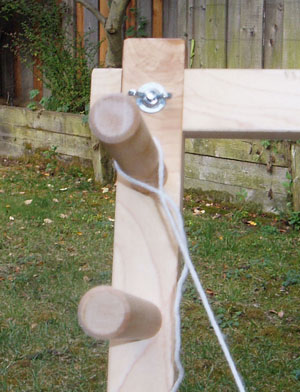
Step 1: Start with a overhand knot to make a loop. Place the loop on the first peg on the upper left hand side.

Step 2: Wrap it around the top 2 pegs counter clockwise. I chose counter clockwise because I wanted a clean transition to the next peg down. In these socks, I wrapped around the top set of pegs 5 times. This translated into about 7 knitted rows for me (64 sts/round). (Note: The pegs on my warping board are approximately 18″ apart, instead of the recommended 15″, which is why there are a couple of extra rows.)
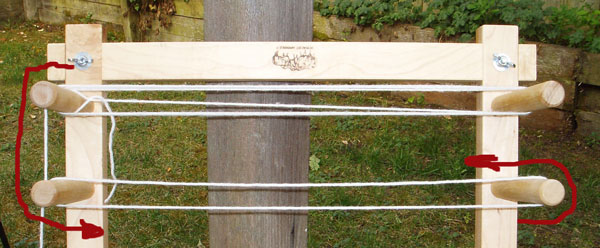
Step 3: After 5 wraps, move down to the next set of pegs. I chose to have one wrap of white between each color segment.
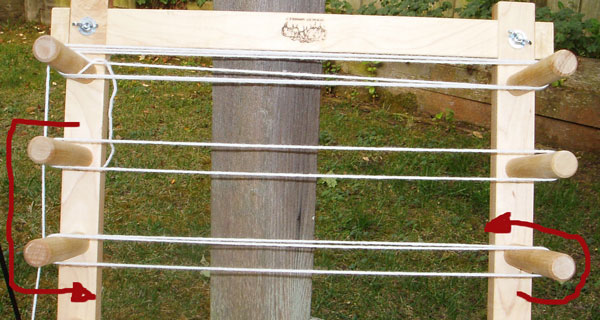
Step 4: Continue on down to the 3rd set of pegs. For the purposes of this demonstration, I’m only showing you 2 color stripes. For my socks, I made 3 color stripes. That’s the max that this warping board will make, since there are only 5 sets of pegs: 3 color stripes, with 1 stripe of white in between.
Technically, you can have 5 color stripes, if you forgo the plain white stripes.
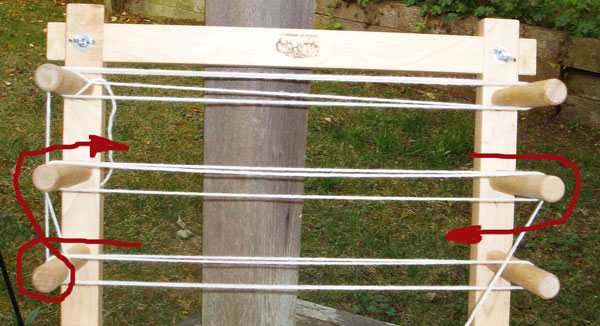
Step 5: This is where it gets interesting. I had to reverse the direction of my wrap from counter clockwise to clockwise to move to the pegs above. This necessitated a full wrap around the current row’s left peg before moving up one row.
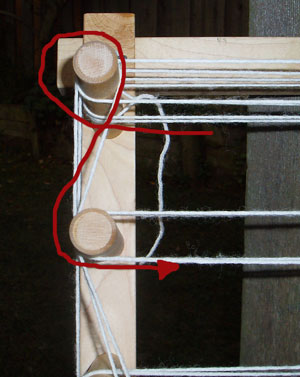
Step 6: Once you reach the top set of pegs, you need to reverse directions again before you head back down. Repeat Steps 1-6 until you run out of yarn.
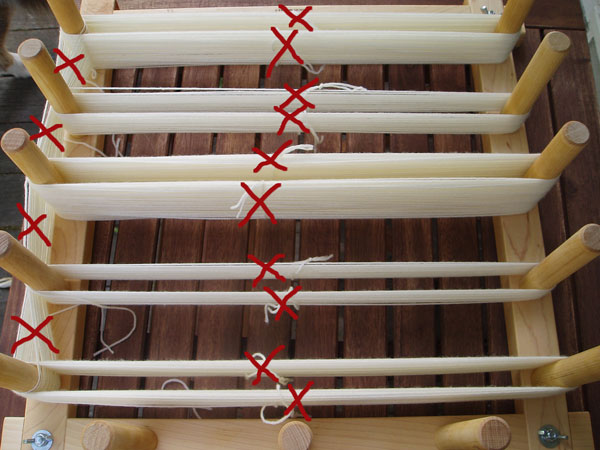
Tie Up: Once you have wound off all of your yarn, you need to tie them up into neat little bundles. The red “X” marks where I tied off.
First, you want to tie loose figure 8 knots along the legs of the loops. You want to keep it loose because you want the dye to penetrate the yarn. If too tight, you will get a light spot where the dye wasn’t able to penetrate. They are only there to keep the loops neat and tidy.
The knots along the edges where you change from peg to peg should be firm knots. This is where the color changes will occur, so you don’t really want the dye to bleed from one area to the other. This is the other reason that I used a white section between the color stripes. I now don’t have to worry about how close to the ties to dye. Lazy of me, I know, but what can I say. It’s perfect for a first time out. Keep it simple.
There’s one thing that bothers me with my wind/tie up. The extra round-the-peg loop that I had to do to reverse direction. This did not make for a nice neat bundle when I took it off the warping board. And for the anal retentives, this will not produce perfectly equal color segments, because of the extra yarn required to make it all the way around the peg. Depending on the size of your pegs, you can be talking about 3″ of extra yarn for each color change. My pegs are about 3/4″ diameter, so we are talking about 2.5 extra inches.
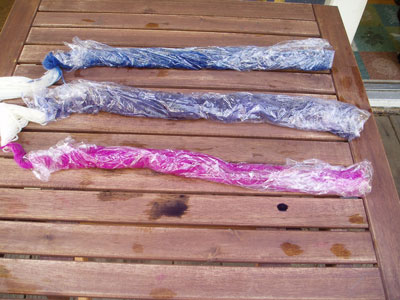
There you have it. I moved the single wrap bundles (white) to hang off of my dye table, placed the remaining 3 bundles on their own sheets of plastic wrap, painted them with dye (and vinegar!), wrapped up the bundles and zapped it in the microwave. That’s it. Hand dyed self patterning sock yarn!

Grace
Thanks! That was very illuminating.
fibergal
I loved your explanation. However, what I would especially like to see is how you wind it back up after it is dyed. Do you reload onto the warp board or just hand-wind?
Ann
Both. Because I abused the yarn a bit, trying to work the vinegar in after the fact, the yarn fulled a bit. And the loops were no longer in nice neat bundles anymore.
So, I hung the loops on one set of the pegs, while I gently worked the yarn free while I wound it on my nostepinne. Then, I rewound it again with my ball winder. And then, once again, into 2 separate, and almost equal sized, center pull balls that started at the same point in the color repeats.
Next time, I would divide the yarn into 2 equal amounts before winding on the warping board and dyeing. This way, I would have exactly equal sized balls that started at the same point.
Live & learn.